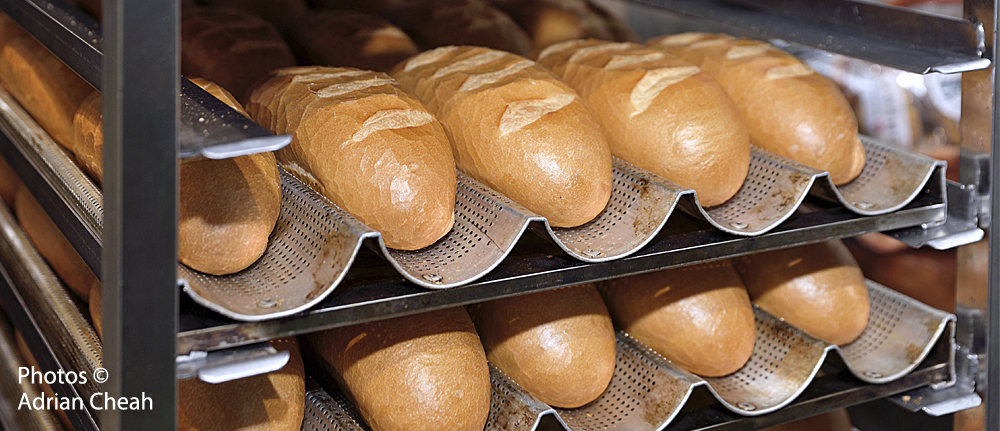Banh Mi Kitchen – serving up authentic Vietnamese bánh mì and more

As the name of the restaurant highlights, Banh Mi Kitchen focuses mainly on offering the iconic Vietnamese bánh mì sandwiches. Freshly baked baguettes, spread with pâté and margarine, are packed with a selection of stuffings (including ham, barbecue pork, roasted chicken, meat balls, prawns, fish, eggs or pork floss), topped with cucumber, pickled daikon and carrot, fresh cilantro and fiery chilli peppers for an extra kick.

Although there are a handful of other Vietnamese delights on offer, bánh mì takes centre stage on the menu.
Bánh mì (Vietnamese for "wheat cake") is the name of the bread itself, as well as the filled sandwich. At Banh Mi Kitchen, the light crispy baguettes, are baked in-house daily to ensure freshness. The uniqueness of the Vietnamese baguette is that it is extremely light. The crispy super thin crust encases a pillowy inside that is so airy. Each loaf measuring about nine inches in length with a circumference of about 10 inches, makes it an ideal size to make a hearty sandwich.

Contrary to popular belief, the bánh mì dough does not contain any rice flour nowadays. The desired texture is obtained by using good bread flour instead of regular all-purpose flour. Also, a lot of steam is required in the oven to allow the crust to develop and stay thin and super crispy.
The traditional French baguettes, on the other hand, has a much thicker crust and a denser, chewy interior. It is also shaped longer with a smaller circumference.

Saigon was the capital of the French protectorate of Cochinchina (1862–1954) and of South Vietnam (1954–1975). Besides opulent buildings, the French colonial masters also left a distinct mark in the culinary infusion in some of Vietnam's popular dishes enjoyed today not only in the country but the world over.
Bánh mì's humble beginnings
The bánh mì, as we know it today, only came about after the French-held garrison at Dien Bien Phu fell on 7 May 1954. When the French left, Vietnamese cooks eventually modified French dishes to suit the local palate, incorporating local ingredients. Using the French baguette, a Vietnamese take on the European sandwich gave birth to bánh mì, an affordable dish the locals could enjoy. Packed with sweet and tangy pickles, fresh herbs, pâté and more, the refreshing sandwich is hearty and truly comforting. Today, the revolutionary bánh mì has secured its status as one of Southeast Asia’s most noteworthy street foods.
The exact origin story of bánh mì is disputed. Having said that, Lê Minh Ngọc and Nguyễn Thị Tịnh who established Bánh Mì Hòa Mã in 1958 must have been two among the first few to make bánh mì a business. Three generations later, the small restaurant is still operating at the same spot in District 3 in Ho Chi Minh City.


Luckily for us living in Penang, we do not have to travel that far to enjoy the irresistible bánh mì. We can get our fix right in the heart of George Town at 86, Jalan Zainal Abidin. The sandwiches are prepared right before your eyes and you have the option to customise your order, deciding on the degree of spiciness and personal preferences.

The brainchild of this operation is Ipoh-born Mr. Kelvin Chua. Having learnt all that he needed to know about bánh mì in Vietnam, he headed back to Malaysia. In December 2019, he established Banh Mi Kitchen in Penang. There are many components to make a truly authentic bánh mì including the baguette and of course, the heart of the sandwich – the pâté. Like the baguette, the pork pâté is also prepared in-house to control the quality.
Other classic Vietnamese dishes on offer include rice paper rolls with shrimps or roast pork served on the side with dipping sauce, crispy golden fried spring rolls and cold vermicelli as well as soup, garlic bread and items to share.

For drinks, try the Vietnamese iced or hot coffee, iced plum and mint soda as well as sugarcane with lime. The aromatic imported coffee beans, roasted to perfection, are freshly grounded and brewed at the restaurant. If you are a coffee connoisseur, you would immediately recognise the excellent brew synonymous with Vietnamese coffee. There are also smoothies and a selection of teas available.
Combo sets are also available at the restaurant, each being a few Ringgit cheaper when compared to items ordered separately. Look out for special promotions and new items on the menus as well.
To conclude the meal with a sweet treat, opt for the panna cotta, topped with mango or grass jelly. The silky smooth custard is creamy and delicious. Other desserts include chocolate brownies, a "genie in a glass" (sundae with homemade chocolate cookies) and choux à la crème (vanilla cream puffs).

The casual air-conditioned dining area provides a conducive setting for you to enjoy your quintessential Vietnamese sandwich. Friendly staff is at hand to ensure that you have a memorable encounter. So fellow bánh mì lovers, wait no longer and make a bee line to Banh Mi Kitchen to sate your appetite.

Banh Mi Kitchen
No. 86, Jalan Zainal Abidin, 10400 George Town, Penang
T: +604-226 3886
Open daily: 9 am to 9 pm
-------------------------------------
Written and photographed by Adrian Cheah
© All rights reserved
2 February 2023